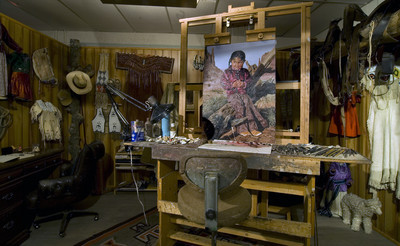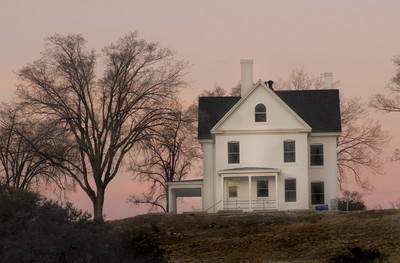Taking my pick of Prescott
A trip to Prescott, in central Arizona, may not be the first getaway springing to the mind of a heat-tortured Las Vegan. Yet, with a mile-high elevation and set in a ponderosa pine forest, Prescott's average daily maximum temperature is only 85 degrees in June and 88 in July, dropping to the 50s at night. Its four-season climate attracts both winter and summer visitors, for indoor and outdoor pursuits.
The town offers an eclectic menu of history, art, rodeos and natural beauty. For that reason I go any season I can, and enjoy the variety. On my latest trip I picked one activity from the art column, one from outdoor and one from history.
My art adventure is a stop at the Phippen Art Museum on Prescott's northern city limit. It's named for George Phippen (1915-1966), a local artist and sculptor and the first president of the Cowboy Artists of America. Besides a permanent display of Phippen's work, it contains a choice collection of other sculptures and paintings from the American West, and three or four exhibits from other artists change throughout the year.
Right now, the work of Ray Swanson (exhibit ends July 6) is showcased. Most of his oil paintings are of American Indians and in many cases, the museum displays the clothes worn in the painting. Just inside the front door, the velvet blouse decorated with silver dimes and a tiered long skirt are displayed next to the painting of a Navajo woman. It's interesting to compare the real thing to the image an artificer charmed out of oil paint. It's easy to spend hours here.
My outdoor activity isn't much farther down Highway 89, in Granite Dells. The road passes through a jumble of immense, sand-colored, granite boulders that look as if a giant lost his marbles here -- a whole bagful of oversized aggies. These rounded rocks are in the final stage of a process called spheroidal weathering that smooths any sharp corners off the granite.
Today, Highway 89 cuts through the middle of Granite Dells, but in early days the only way through the hodgepodge of boulders was to fight the heavy vegetation along Granite Creek. Early stagecoaches from Prescott to the Flagstaff area passed around the east side of the rocks, while the stage going north to Ash Fork skirted Granite Dells on the west side.
During the late 19th century, Granite Dells contained a resort. In the early 1900s, Prescott's weather and elevation was touted as making a good place to recover from tuberculosis. Visitors came to heal and enjoy themselves. Later, movie stars such as Tom Mix had homes among the rocks. When Granite Creek was dammed, picnic facilities and lawns were added to make Watson Lake Park, so Granite Dells is still a favorite gathering site.
I spot a kayaker sharing the lake with a pair of mallard ducks while two boys are boulder hopping. Their dog, just as agile, keeps up with the boys as they explore.
Watson Lake is a deep blue with buff-colored boulders coming clear down to the shoreline. One giant slab of granite looks like it was sliced with a bread knife. The San Francisco Peaks near Flagstaff are clearly visible on the horizon making for a great photo opportunity. A small granite island sits in the lake, barren except for a couple of sturdy yuccas that protrude from cracks containing just enough soil to allow their survival.
I've seen man-made art and Mother Nature's handiwork and now I'm ready for a history lesson. Back on Highway 89, I'm on the lookout for the Fort Whipple Museum located on the grounds of the Veterans Affairs Medical Center. The hospital's stark white buildings on the west side of the road can't be missed. Camp Whipple, established in 1864 during the Indian Wars, became Fort Whipple. It was here that Prescott-area recruits to the First United States Volunteer Cavalry -- better known as the Rough Riders -- assembled before their appointment with destiny on San Juan Hill in the Spanish-American War.
From 1898 to 1901, Fort Whipple was inactive. Some say that intense lobbying of Arthur MacArthur, a Civil War hero and influential general in the U.S. Army, during a 1902 visit to Prescott, led to the post being reactivated. New buildings housed a full infantry regiment with a troop of cavalry and necessary service troops -- about 900 officers and men. Look to your left along the ridge. The two-story Victorian-style homes were for officers and are still occupied by hospital personnel.
Fort Whipple was declared obsolete again in 1912 and only a caretaker force remained until World War I brought the post back into demand, this time as an Army hospital. It became one of the most complete tuberculosis sanatoriums in the country and also cared for many soldiers who had been gassed during the war.
After you drive into the hospital grounds, watch for a small sign directing you to the Fort Whipple Museum. Hint: The museum is the only building not white and it's not far from a large teepee. The teepee is used by American Indian patients for their ceremonies.
The museum, located in a 1906 home that probably served as quarters for single officers, is painted a soft yellow with green trim. With the wide porch and an immense Arizona Cypress out front, it isn't hard to imagine young soldiers lounging about.
Inside the Fort Whipple Museum, I find an interesting collection of military memorabilia and old medical instruments. The guide patiently answers all my questions and throws in a few stories of his own . I am especially interested in General George Crook, one of the military leaders during the Indian Wars. Crook was a unique character. Instead of a horse, he rode a mule, claiming they were more sure-footed. He didn't wear his uniform when out on patrol -- that would have made him a target -- and he wore a pith helmet instead of the slouch hat then favored by most officers.
I've spent a whole day and haven't yet made it into downtown Prescott to buy a sasparilla on Whiskey Row or tip my hat to the marvelous statue of Prescott's hero, Buckey O'Neil. But, there's always tomorrow.
In a town with so many attractions, and summers so cool, I'm looking for an excuse to stay longer.
GETTING THERE Location: Prescott, about 250 miles southeast of Las Vegas. Attractions described in this article are on the northern edge of town. Directions: From Las Vegas’ infamous “Spaghetti Bowl” intersection of U.S. 95 and Interstate 15, take U.S. 95 south 105 miles to Kingman, Ariz. Merge onto Interstate 40 toward Flagstaff, turning off after 96 miles at Ash Fork on State Route 89 South, for 46 miles to northern edge of Prescott city limits. Best time to visit: Watson Lake, April to October; Phippen Museum and Fort Whipple -- year around. General Information: Prescott Area Coalition for Tourism, 928-708-9336, www.visit- prescott.com. Phippen Museum: 4701 Highway 89 North, pen 10 a.m.-4 p.m. Tuesday-Saturday; 1-4 p.m. Sunday. Closed Mondays. 928-778-1385, www.phippen artmuseum.org. Watson Lake Park (Granite Dells): From the traffic circle on Highway 89 take the third exit onto Watson Lake Park Road. Summer hours, 6 a.m.-10 p.m. Normally open 7 a.m to dusk. Fort Whipple Museum: 500 N. Highway 89, Prescott (branch of Sharlot Hall Museum, 928-445-3122, www.sharlot.org). Open Thursday, Friday, Saturday 10 a.m.-4 p.m. Accommodations: Hassayampa Inn, a historic site, 122 E. Gurley St., 800-322-1927, www.hassayampa inn.com. Hotel St. Michaels, historic, 205 W. Gurley St., 800-678-3757, www.stmichael hotel.com. Comfort Inn of Prescott, 1290 White Spar Road, 928-778-5770, www.comfort inn.com.


















